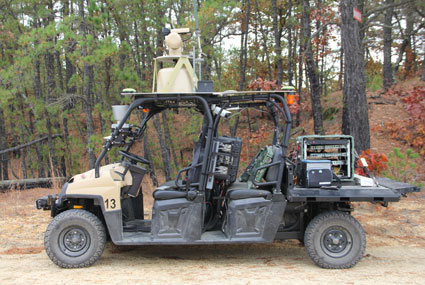Army teams up with robot vehicles
CERDEC researchers demonstrate how autonomous ground vehicles can work with soldiers to establish beyond-line-of-sight communications.

CERDEC used two Modular Detection and Response System robots in the tests.
The move to fully autonomous ground vehicles might still be a ways off, but Army researchers took a step in that direction recently, demonstrating how two robot vehicles could work with ground forces to extend communications beyond the line of sight.
The demonstration, at Joint Base McGuire-Dix-Lakehurst, N.J., in early November, featured two Modular Detection and Response System, or MDARS, robots that, in a tactical scenario, autonomously drove to their destinations while streaming video to a manned chase vehicle. In the process, it showed two things the Army is looking for with autonomous vehicles: that one soldier could use multiple unmanned vehicles and that maintaining control of them doesn’t have to require a lot of effort.
Conducted by the Army’s Communications-Electronics Research, Development and Engineering Center, or CERDEC, the exercise demonstrated how unmanned ground vehicles, or UGVs, could be used to establish beyond-line-of-sight communications, in a way similar to how unmanned aircraft can be used a relay nodes on a tactical network.
The tests also showed how commanders could use Mission Command applications to direct the UGVs, make use of the UGVs’ sensor data to inform situational awareness and targeting, and engage an enemy from beyond line of sight, CERDEC said in a report.
CERDEC’s Technology Enhancements in Autonomous Machines, or C-TEAM, conducted the exercise, building on more than a year’s worth of work by four CERDEC directorates.
"We are setting a new baseline for a number of technologies used on robotic vehicles that are a step beyond teleoperated systems," said Chuck Shoemaker, CERDEC’s lead for autonomous systems.
The military is well-known for its use of unmanned aerial systems, but it also has been putting a lot of effort into developing unmanned ground systems, such as driverless convoys, and ocean-going systems. But while researchers have been able to integrate a measure of autonomy into various planes, boats and ground vehicles, fully autonomous vehicles that can account for changes in terrain and unexpected occurrences is at least a decade away.
Exercises such as the C-TEAM’s, which focused on navigation, communications, command and control, gets them a little closer. Researchers also are working to identify new sensors with enough resolution and scan rate to improve a system’s ability to see what’s ahead, among them a new a new class of Laser Imagining and Detection Systems, or LIDARs, a 3D geospatial tool.
"It's important to have sensor LIDARS on the vehicle to ensure minimal latency and detect obstacles in field of view for robot and ensure maneuvers around the obstacles," Shoemaker said. The development of technologies in those focus areas, CERDEC said, will play a big part in how those technologies are deployed. "The technologies demonstrated are invaluable to the soldiers," Shoemaker said.




